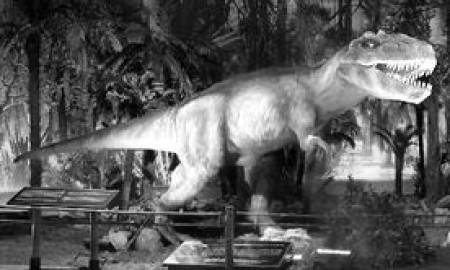[Sent to me by Troodon Roar on Facebook-DD]
EXCLUSIVE: Real Life Dinosaur Sighting!

Ever dreamed of seeing a dinosaur in the flesh? Some people claim dinosaurs still live in remote regions of the world. The following is a story that came from one of our readers, Weldon Abbot, M.D., about a frightening encounter he had with a young T-Rex many years ago:
I once saw a living dinosaur in the Kalahari Desert just a few miles north of Windhoek in 1949. I was in Cape Town South Africa when I saw in the newspaper that there was an epidemic of bubonic plague in Windhoek.Read the rest of this exciting story after the jump …
I am a physician and since I had never seen a case of bubonic plague, I took the next plane from Cape Town to Windhoek, I went and met the English physician there who had remained there after the war and who had the cases of bubonic plague in a makeshift hospital there.Here’s a map of the area for those of a geographic state of mind.

You can see the city that Dr. Weddon is referring to at the center of the map. Now back to the story:
When I landed in Windhoek it was raining and the locals told me that it was the first time it had rained in seven years. The day after I went to see the cases of bubonic plague I decided to take a hike out into the Kalahari Desert. I hiked for an hour or two north of the small town and while walking in a dry stream bed there suddenly came around a bend in the dry bed and, about40 yards ahead of me, stood a dinosaur that looked like a small tyrannosaurus rex. Same body configuration, shape, rough skin and color. Its mouth was closed so I did not see any teeth. It was about my eighth, about 5′ 8″, I would judge since eye levels were about the same.Dr. Abbot may not be aware of this, but modern paleontologists suggest that the tyrannosaurus rex was at least this small or smaller well into adolescence. Unlike modern mammals, they didn’t see slow growth over many years, but had a massive growth spurt just prior to adulthood. For more on this theory, click here. But now back to our exciting story:
Shocked and surprised, we both froze. Our eyes fixed on each other. This must have lasted about 5 seconds. Then the dinosaur turned and took off up the wade in the direction from which it had come. I went on up to the bend in the dry stream bed and then watched the dinosaur running for 200 yards and then it turned to the left and disappeared. The locals that I spoke with when I got back to Windhoek had never heard of such a thing around there. The next day I boarded a plane back to Cape Town and did not say anything more to anyone about the incident because the few people that I mentioned it to found the story hard to believe, which is understandable but it remains a true story, nevertheless.It’s a wonderful story. And we’re so glad Dr. Abbot shared it with us.
[Troodon was especially interested in this separate report from Kansas in 2010:]
11 Responses to “EXCLUSIVE: Real Life Dinosaur Sighting!”
-Best Wishes, Dale D.]










 I believe what we have here is a depiction of a ceratopsian dinosaur that differs slightly from what one expects given modern depictions. The beak is slightly less pronounced-but evident. The horns are actually in the exact place on its head as the horns on modern Chasmosaurus depictions. The creature has growths (possibly pre-horn?) growths on the front of its face that are not seen on ceratopsian depictions.
I believe what we have here is a depiction of a ceratopsian dinosaur that differs slightly from what one expects given modern depictions. The beak is slightly less pronounced-but evident. The horns are actually in the exact place on its head as the horns on modern Chasmosaurus depictions. The creature has growths (possibly pre-horn?) growths on the front of its face that are not seen on ceratopsian depictions.































January 27, 2013 at 7:29 pm
January 31, 2013 at 1:43 pm
But what makes you think this was a dino? Could it have been a modern lizard engaging in bipedal movement? There are some that do this.
March 1, 2013 at 4:57 am
March 4, 2013 at 3:21 pm
June 28, 2013 at 9:24 pm
June 28, 2013 at 9:30 pm
June 29, 2013 at 3:47 pm